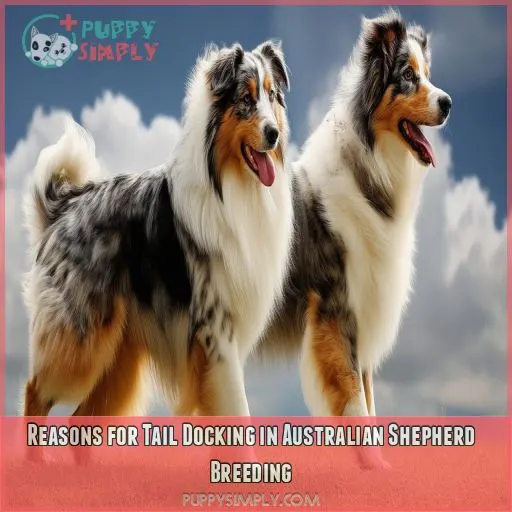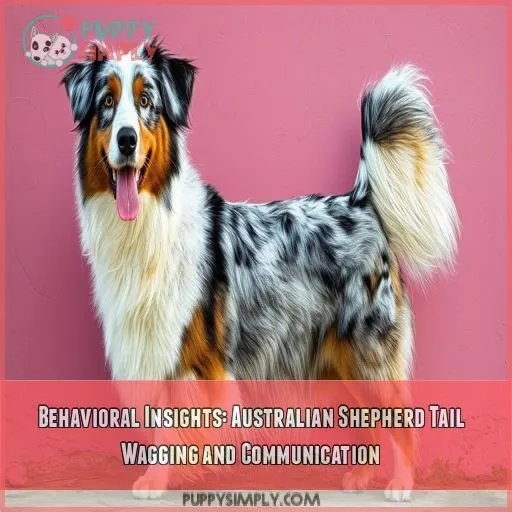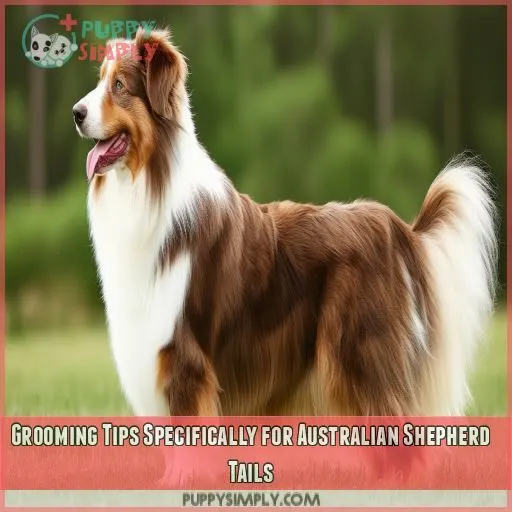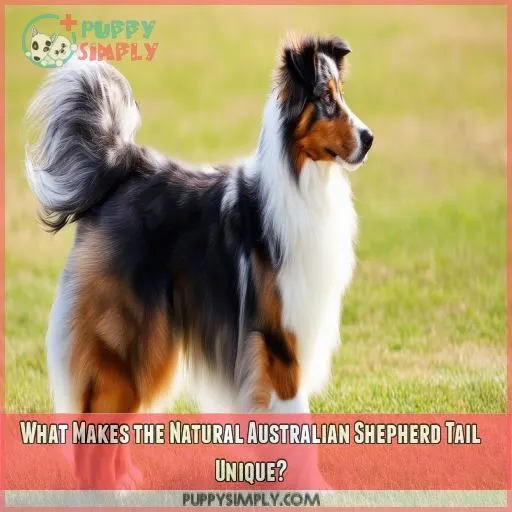This site is supported by our readers. We may earn a commission, at no cost to you, if you purchase through links.
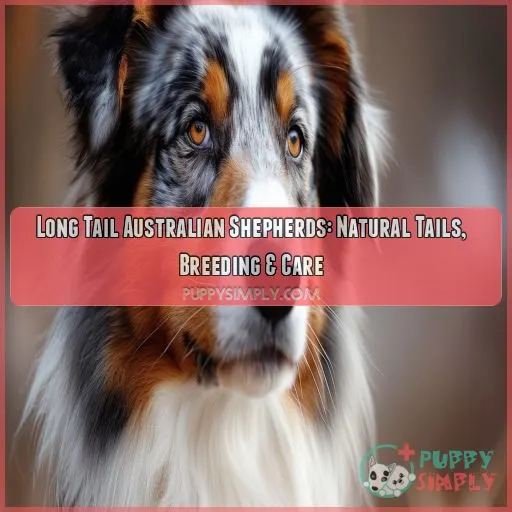
However, finding a breeder who offers these long-tailed Aussies can be challenging. Tail docking remains a common practice among breeders today.
This guide will take you on a journey to discover the beauty of natural tails, explore breeding practices, and provide essential care tips for your furry friend’s tail. Get ready to immerse yourself in the world of Long-Tail Australian Shepherds and uncover the secrets of their beautiful, natural tails!
Table Of Contents
- Key Takeaways
- Does the Australian Shepherd Breed Have Naturally Bobbed Tails?
- Reasons for Tail Docking in Australian Shepherd Breeding
- Understanding the Tail Docking Procedure and Its Implications
- Finding Breeders Who Leave Australian Shepherd Tails Undocked
- Behavioral Insights: Australian Shepherd Tail Wagging and Communication
- Australian Shepherd Tail Health: Common Problems and Care
- Grooming Tips Specifically for Australian Shepherd Tails
- What Makes the Natural Australian Shepherd Tail Unique?
- Frequently Asked Questions (FAQs)
- Conclusion
Key Takeaways
- Tails Tell Tales: The natural tail of an Australian Shepherd is a window into its soul, reflecting their emotions and communicating their intentions.
- Undocked Beauty: Leaving Aussie tails intact preserves their natural balance and agility, letting them wag their way into your heart.
- Healthy Tails, Happy Aussies: Regular tail care, from brushing to hygiene checks, keeps an Aussie’s tail healthy, wagging, and adventure-ready.
- Finding Your Tail-Wagging Match: Connecting with breeders who prioritize natural tails opens doors to finding the perfect long-tailed companion for life’s journey.
Does the Australian Shepherd Breed Have Naturally Bobbed Tails?
You might be curious if those adorable, agile Australian Shepherds are born with naturally docked tails. Well, the answer is yes—and it’s all due to their unique genetics. About one in five Australian Shepherds, or 20% to be precise, are born with naturally docked tails due to an incomplete dominant gene. This means that puppies only need one copy of this gene to sport a cute, short tail. However, it’s worth mentioning that this gene can be a double-edged sword. While it gives Aussies their distinctive appearance, it can also be fatal if two copies of the gene are inherited.
Breeding programs aiming for heritage preservation and natural tail lengths in Australian Shepherds must carefully consider the genetic implications. The bobtail gene can be tricky to work with, and breeders may face challenges in producing healthy puppies with the desired tail length. This ethical dilemma emphasizes the importance of responsible breeding practices that prioritize the health and well-being of these beloved dogs.
Reasons for Tail Docking in Australian Shepherd Breeding
Tail docking in Australian Shepherds is commonly practiced for tradition and to prevent injuries, but it raises significant ethical questions. Arguments against docking highlight the unnecessary pain for puppies and the importance of preserving their natural features.
Tail Docking Benefits
Tail docking has been a common practice among breeders, and while it’s controversial, there are potential benefits. It can prevent burrs and stickers from catching, reducing infection and trauma risks. It’s also considered essential for breed standards, especially for agile working dogs, to prevent injuries.
Arguments Against
There are several compelling arguments against tail docking in Australian Shepherd breeding.
Firstly, it is unnecessary for modern Aussies; tradition and custom do not justify the procedure.
Secondly, the procedure is painful for puppies, and compassionate breeders offer undocked puppies as a more humane alternative.
Additionally, breeding for bobtails can result in serious health complications, including spina bifida and lower spinal cord mutations, which can be fatal.
Tail length is important for communication and expression, and docking can impact an Aussie’s ability to convey their emotions effectively.
Pain Factor
The pain factor is an important consideration in the tail docking debate. While some argue that docking prevents future pain and health problems, others point out the immediate distress it causes puppies.
The procedure is often done without anesthesia, and puppies experience pain and vocalize their discomfort. This raises ethical concerns and questions about puppy welfare. There’s also a risk of dead tail, where nerve damage causes the tail to become limp and unresponsive.
As a breeder, balancing these pain management and recovery time factors is essential when deciding whether to dock or leave tails natural.
Understanding the Tail Docking Procedure and Its Implications
The tail docking procedure involves surgically removing a puppy’s tail, typically using scissors or a rubber band to cut off the blood supply. This is done to Australian Shepherds for a variety of reasons, including aesthetics, compliance with breed standards, and injury prevention. However, it’s important to acknowledge the ethics and implications of this practice.
Here are three key points to keep in mind:
- Pain Management: Tail docking can be painful for puppies, and most breeders don’t use anesthesia or sedation during the procedure. The puppies may experience intense vocalizations and pain.
- Natural Tail Advantages: The natural tail provides balance and agility to Australian Shepherds and is a form of communication, enhancing their expressive body language.
- Tail Length Genetics: Breeding for bobbed tails can be risky, as the gene for a naturally bobbed tail is dominant but can be fatal if two copies are present. This limits the gene pool and may affect other important aspects of the breed.
Finding Breeders Who Leave Australian Shepherd Tails Undocked
If you’re keen on adopting an Australian Shepherd with a natural tail, you’ll need to do some careful research to find responsible breeders who prioritise the health and well-being of their puppies. Here’s what you should keep in mind during your search:
- Communication and Transparency: Look for breeders who are open and responsive in their communication. They should be willing to answer your questions about their breeding practices, the health of their puppies, and the reasons why they choose to leave tails undocked.
- Temperament and Health: Prioritise breeders who focus on producing puppies with excellent temperaments and good health. This includes proper socialisation, health testing of the parent dogs, and providing you with health guarantees and veterinary records for your puppy.
- Meeting Demand: Recognise that there’s a high demand for long-tailed Australian Shepherds. Be prepared to wait for the right breeder and puppy, as responsible breeders who leave tails undocked may have longer waiting lists due to the rarity of this feature.
- Adoption Options: Consider adopting an Australian Shepherd mix or a tail-less Aussie from a rescue organisation. By adopting, you not only give a home to a dog in need but also increase the diversity of the gene pool, which is beneficial for the overall health of the breed.
Behavioral Insights: Australian Shepherd Tail Wagging and Communication
Understanding Australian Shepherd Tail Wagging and Communication
The tail is a crucial form of communication for Australian Shepherds, and their tail-wagging patterns can provide valuable insights into their emotional state and social cues. Here are some key aspects to observe:
- Body Language and Emotional Expression: An Australian Shepherd’s tail can indicate their mood and emotions. For example, a wagging tail might signal excitement or happiness, while a tucked tail could suggest fear or anxiety.
- Social Cues and Communication Patterns: These dogs use their tails to communicate with other dogs and people. They might wag their tails more vigorously when greeting someone they know or use subtle tail movements to indicate their intentions during play or interaction.
- Companion Dog Connection: The tail is an extension of an Australian Shepherd’s personality and can help strengthen the bond with their human companions. Understanding their tail language can enhance your relationship and improve communication.
- Grooming and Chasing: While tail chasing or biting can sometimes be a concern, it can also be a normal part of self-grooming behavior, especially for active dogs like Australian Shepherds.
Understanding the significance of tail wagging and its role in communication can provide insights into the unique behavior and social interactions of Australian Shepherds.
Australian Shepherd Tail Health: Common Problems and Care
As a proud owner of a long-tailed Australian Shepherd, you’ll want to be aware of potential health issues like tail chasing, hot spots, and proper tail posture. Maintaining good grooming habits and keeping an eye on your pup’s tail can help prevent problems and guarantee your Aussie’s tail stays healthy and happy.
Tail Chasing & Tail Biting
Tail chasing and biting are common problems in dogs, and your Aussie is no exception. These behaviours can be frustrating and even destructive if not addressed.
Why do dogs chase their tails? It’s often a self-reinforcing behaviour—the more they do it, the more it becomes a habit. Tail chasing can start as a simple boredom buster or itch relief but can quickly turn into an obsessive-compulsive disorder.
As for tail biting, it’s often a sign of stress or anxiety. Your Aussie might be trying to soothe themselves by biting their tail, or they could be redirecting their frustration onto their tail.
If you notice your Aussie engaging in these behaviours, it’s important to address them early on. Provide plenty of exercise and mental stimulation to keep boredom at bay. Interactive toys, training sessions, and socialisation can all help reduce stress and provide healthy outlets for your dog’s energy.
Hot Spots on Australian Shepherd Tails
Hot spots are a common issue for Australian Shepherds, especially on their tails due to the moisture and warmth in that area. These hotspots can be itchy and uncomfortable for your Aussie, so it’s important to keep an eye out for them.
Good tail hygiene and grooming practices can help prevent hot spots. Make sure to regularly check your Aussie’s tail for any signs of irritation or infection, and consult your veterinarian if you have any concerns.
Tail Posture and Health
Aside from hot spots, there are other tail health issues to be aware of as an Australian Shepherd owner. Here are some common problems and care tips to keep in mind:
- Tail chasing and biting: This can be a sign of anxiety or boredom and may lead to tail injuries. Provide plenty of exercise and mental stimulation to prevent this behavior.
- Tail posture: A healthy tail should be upright and curved like a sabre when your Aussie is attentive or excited. A tucked tail can indicate fear or submission.
- Tail hygiene: Regular grooming and bathing help maintain tail hygiene and prevent skin issues. Pay attention to the tail base, where dirt and debris can accumulate.
- Tail length and wagging: Be mindful of your dog’s tail length, especially in confined spaces, to prevent accidental knocks or breaks. A happy, healthy Aussie will likely have a wagging tail, so remember to give them enough room to express their joy without knocking into things!
Grooming Tips Specifically for Australian Shepherd Tails
Maintaining your Australian Shepherd’s tail in optimal condition necessitates regular grooming, shedding management, and rigorous hygiene practices. These measures guarantee your dog’s comfort and well-being while accentuating the inherent beauty of their tail.
Shaving Your Australian Shepherd’s Tail
Grooming your Aussie’s tail requires special attention to avoid any mishaps. Here are some tips to keep in mind when shaving your Australian Shepherd’s tail:
| Shaving Aspect | Recommendations |
|---|---|
| Shaving Frequency | Shave your Aussie’s tail every 4-6 weeks to maintain a neat appearance. |
| Shaving Techniques | Use a light touch and follow the direction of hair growth to avoid irritation. |
| Shaving Tools | Opt for a high-quality clipper with a sharp blade. |
| Shaving Patterns | Create a natural, blended look by following the contour of the tail. |
| Shaving Risks | Be cautious of nicks and cuts, and apply a soothing balm if necessary. |
Shedding and Tail Maintenance
As an Australian Shepherd owner, you know that shedding is a natural process, but it can be a challenge to keep your dog’s tail looking neat and tidy. Here are some tips to help you maintain your Aussie’s tail:
- Regular brushing: Invest in a good-quality brush designed for double-coated breeds. Brushing your dog’s tail regularly will help remove loose hair and prevent mats and tangles.
- Detangling sprays: If your Aussie’s tail tends to get knotted, use a detangling spray before brushing to make the process easier and more comfortable for your dog.
- Bathing and conditioning: When you bathe your Aussie, pay extra attention to their tail. Use a gentle shampoo and conditioner to keep the hair soft and manageable.
- Trimming: While you may not want to shave your Aussie’s tail, light trimming can help keep it looking neat. Trim any stray hairs and shape the tail to your desired length and style.
Hygiene Practices for Tails
Maintaining tail hygiene is essential for your Aussie’s overall health and well-being. Here are some tips to keep their tail clean and healthy:
| Tip | Reason | Impact |
|---|---|---|
| Regular brushing | Removes dirt and debris | Maintains tail cleanliness |
| Tail shampooing | Deep cleanses the tail | Enhances tail hygiene |
| Conditioning | Moisturizes and detangles | Promotes a healthy tail coat |
| Tail inspection | Detects potential issues | Ensures tail health |
What Makes the Natural Australian Shepherd Tail Unique?
The natural tail of an Australian Shepherd is a beautiful feature that sets this breed apart. Here’s what makes it special:
- Tail Length and Shape: Natural Aussie tails come in a variety of lengths, from short and perky bobtails to long, flowing tails that swish with every step. The shape can vary too, with some tapering to a point, while others have a blunt end, adding a unique touch.
- Tail Communication: An Aussie’s tail is an extension of their vibrant personality and a powerful tool for communication. The position and movement of their tail can speak volumes about their mood, energy level, and even their health. A happy, wagging tail is a sure sign of an Aussie’s playful spirit!
- Tail Grooming: While grooming an Aussie’s tail is essential for hygiene and maintenance, it’s also a special bonding moment. Brushing and caring for their tail creates a relaxing ritual that deepens the connection between you and your furry friend.
- Tail Health: Keeping an eye on your Aussie’s tail health is of utmost importance. Common issues like tail chasing, biting, or hot spots can be indicators of underlying health or behavioural concerns. Regular checks verify your dog’s tail stays healthy, and any potential issues are caught early.
- Natural Charm: Natural Aussie tails contribute to the overall charm and appeal of this beloved breed. They provide balance and agility, enhancing the graceful movements of these energetic dogs. Aussie tails truly are a tail-above the rest!
Preserving and celebrating the natural tail of Australian Shepherds is about more than just aesthetics; it’s about honouring the unique characteristics that make this breed so exceptional and beloved by many.
Frequently Asked Questions (FAQs)
What are the benefits of leaving an Aussies tail undocked?
Leaving an Aussie’s tail undocked maintains the natural balance of the dog’s body. Undocked tails are also long and feathered, with a thick base that tapers to a point.
How common is tail docking in Australian Shepherds?
Tail docking is common in Australian Shepherds, with most breeders historically docking puppies’ tails at birth. However, 1 in 5 Aussies are born with naturally bobbed tails, and some breeders now leave tails intact.
Are there any health risks associated with the bobtail gene?
The Bobtail gene itself doesn’t cause health issues, but studies suggest a possible link to spina bifida. Breeding two dogs with natural bobtails may cause reduced litter sizes as 25% of puppies will die in the womb.
What are the alternatives to surgical tail docking?
If you’re looking for alternatives to surgical tail docking, you’ve got options! There’s partial docking, selective breeding for naturally shorter tails, and cosmetic devices like tail wraps. You can also adopt a dog breed with naturally bobbed tails, like an Australian Shepherd.
How do I find breeders who dont dock tails?
You can find breeders who don’t dock tails by searching online and contacting breeders directly. Some breeders may be willing to leave tails intact if you pay for the dog in advance.
Conclusion
Now, you are well-equipped to find a breeder who offers the long-tailed Australian Shepherds you desire.
You’ve discovered the beauty of natural tails, explored breeding practices, and gained essential insights into tail health, behavior, and grooming.


